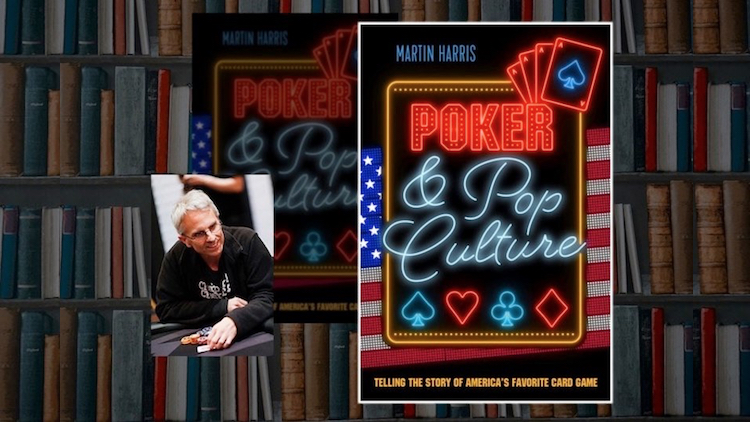You might have heard the final nominees for the Global Poker Awards have been announced. This year 25 trophies will be given out in a wide variety of categories to players, casino and tournament staff, and media at the PokerGO Studio in Las Vegas on Friday, March 6. Click here for a full rundown of all the categories and nominees.
Among those in the running will be PokerStars Blog’s own Martin Harris for his history of poker and its place in American culture, Poker & Pop Culture: Telling the Story of America’s Favorite Card Game. Harris’ book made the cut as one of the four nominees for “Media Content: Written.”
Anthony Holden, author of Big Deal and Bigger Deal, calls Poker & Pop Culture “a thorough, well-informed and highly entertaining exploration of the cultural riches bred by poker, explaining why the game remains so quintessentially American while growing ever more universal.”


A recent photo of the author alongside one of the more influential figures (when it comes to poker’s place in American culture) among the hundreds discussed in his book
Meanwhile David G. Schwartz, author of Roll the Bones and other top titles covering the history of gambling, says Poker & Pop Culture is “the most detailed history of America’s favorite card game I’ve read yet,” calling it a “a monumentally readable, always engaging look at how poker has appeared in literature, television, movies, and other places.”
As Schwartz notes, Poker & Pop Culture covers poker’s origins and early history all of the way through to the present, describing how it was first played on steamboats and saloons, in Civil War encampments, and eventually in clubs, private homes, casinos, and on the computer. It also covers the many ways poker has intersected with other areas of American life including business, sports, entertainment, politics, and warfare.
The chapter “Poker on the Newsstand” focuses largely on poker popping up in American print magazines from the 19th century to present, in particular highlighting how the game has been discussed in mainstream (or “non-poker”) publications. The chapter comprehensively covers general interest magazines (e.g., Life, The Saturday Evening Post, The New Yorker), news and sports magazines (Time, Newsweek, Sports Illustrated), music and humor magazines (Rolling Stone, MAD), and men’s and women’s magazines (Playboy, Esquire, Cosmopolitan, Ms.). And yes, there’s some discussion of “poker magazines,” too, like Card Player and Bluff.
The following excerpt from “Poker on the Newsstand” comes from the section showing how poker has been reported on — and joked about — in various humor magazines throughout history.
from “Poker on the Newsstand”
Humor magazines have likewise occasionally reflected poker’s place in American culture. Begun in 1881, the weekly satirical magazine Judge was quite popular for much of its run until circulation dropped off during the Great Depression and publication ceased in 1947. Poker references were occasionally sprinkled throughout the jokes, stories, and cartoons. Humor produced by married couples’ conflicts was a common theme, with poker sometimes providing the context such as in an 1893 one-panel cartoon titled “Giving Himself Away.” A wife asks her husband about the poker chips she’s found in the pockets of a pair of slacks, and he responds uncertainly “I guess they are waiting for some darned fool to play them.” The wife answers, “Then you do play poker?”
Later in a 1922 issue of Judge journalist Heywood Broun (another participant in the Algonquin Round Table poker game) focused on poker for his “Sport Page.” In a column titled “Just One More Round,” Broun highlights the many ways he believes “of all American sports poker is preeminent as a character builder,” arguing that it especially builds tenacity. In fact, there’s never any reason to quit poker, he points out, since “the courageous player will never think of stopping while he is behind. The proud participant will scorn to quit as long as he is ahead. And the man who is just even, or almost so, will want to go on a little longer until something decisive happens.” Broun jokes as well how poker is only “poignantly” played when the stakes are meaningful (played with “distress money”), and that it is potentially harmful to bottle up one’s emotions while playing. “The player whose flush loses to a full house risks a nervous breakdown in later life if he does no more than remark pleasantly, ‘You win, old chap!'”


Cartoons accompanying Heywood Broun’s “Just One More Round” for a 1922 issue of “Judge”
As Broun explains, the topic of his column was prompted by “Mr. Edison’s latest questionnaire,” a reference to an intelligence test Thomas Edison gave to prospective employees wishing to work at his plant. The questionnaire became public in 1921 thanks to articles in The New York Times for which test-takers supplied many of the questions they had been asked about history, science, art, geography, literature, and other topics. As a result of the questions becoming public, Edison revised his questionnaire, then in 1922 added more questions to another test for those applying to become his personal assistant. The tests were administered orally, with Edison asking the questions and interviewees shouting their responses (as he was hard of hearing). Some of those questions later became public as well, including the following:
“You have only $10 in the world and are playing poker with a man you have never seen before. On the first deal he holds a pat hand. You have three eights before the draw. There is 50 cents in the pot. He bets a quarter. What are you going to do and why?”
In 1952 a new humor magazine appeared called Mad which soon began dominating that segment of the market. Starting as a comic book before developing a more wide-ranging satirical approach, the magazine’s parodies of popular culture were often directed toward a younger audience although equally appealed to adults. Other popular magazines joined Mad‘s targets and it began referring to The Saturday Evening Pest, National Osographic and Sports Inebriated. During most of its run Mad mostly treated poker in a superficial way, such as in 1962 when featuring the gap-toothed mascot Alfred E. Neuman on the cover as the joker in a full house. However in 2005 Mad devoted several pages to a “Celebrity Poker Issue,” including a multi-page skewering of the popular cable show Celebrity Poker Showdown. “They’re depending on luck over skill,” remarks one observer, to which another responds “That’s how most of them became celebrities in the first place.”
A focus of the humor, and thus the commentary, is on the oversaturation of poker-themed content during the mid-2000s, a phenomenon for which a show like Celebrity Poker Showdown stood as a kind of emblem. Another spectator complains that he likes poker, “but between watching Celebrity Poker Showdown, ESPN World Series of Poker, Ultimate Poker Challenge and Poker Superstars, who has the friggin’ time to actually play?” Elsewhere in the issue, a series of cartoons titled “Thanks to the Popularity of Poker…” offers various predictions regarding where the overabundance of poker-themed content is heading (e.g., poker players on Wheaties boxes, fantasy celebrity poker leagues). Another “Mad ad parody” pitches an instructional video, “Ben Affleck: The Art of the Poker Face,” simultaneously poking fun at celebrity poker and Affleck’s sometimes detached-seeming acting style. Rounding out the issue is a multi-page parody of the then-popular HBO drama Deadwood including a lament over the early death of the series’ most charismatic character, Wild Bill Hiccup.
Poker & Pop Culture: Telling the Story of America’s Favorite Card Game is available in paperback, as an e-book, and as an audio book (read by the author) at D&B Poker.
D&B Publishing (using the imprint D&B Poker) was created by Dan Addelman and Byron Jacobs 15 years ago. Since then it has become one of the leading publishers of poker books with titles by Phil Hellmuth, Jonathan Little, Mike Sexton, Chris Moorman, Dr. Patricia Cardner, Lance Bradley, Greg Raymer and more, all of which are available at D&B Poker.
Back to Top







